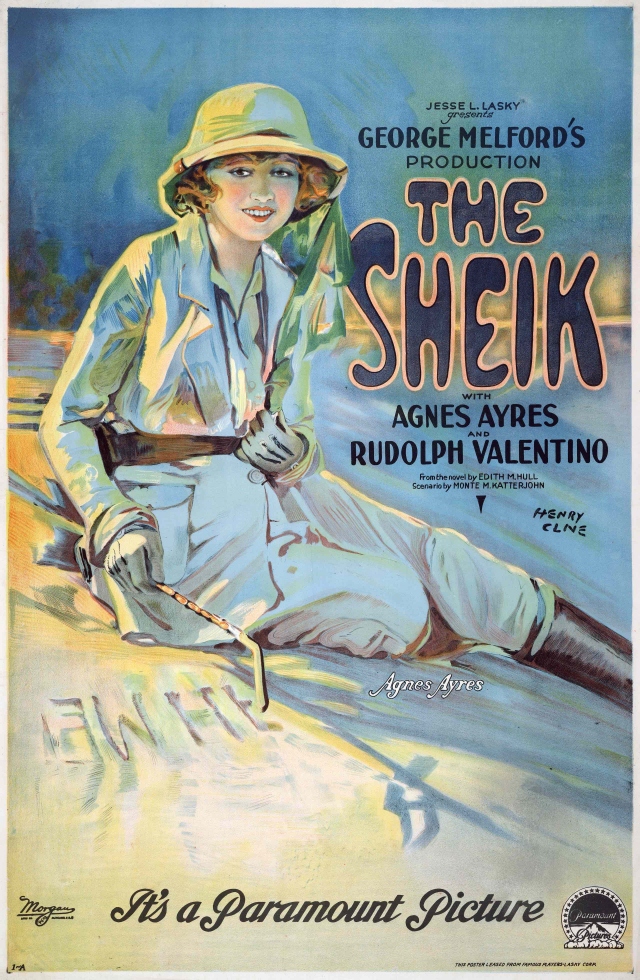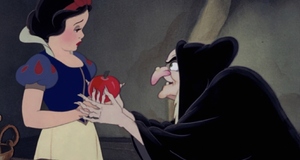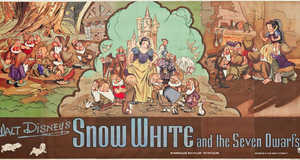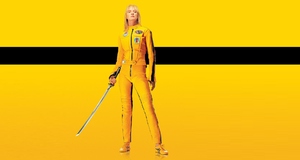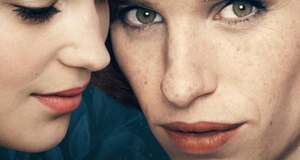Gender Dynamics in The Sheik as Novel and as Film Adaptation
By
2020, Vol. 12 No. 02 | pg. 1/1
KEYWORDS:
The 1921 Hollywood film The Sheik tells the story of Lady Diana Mayo, a spirited English peeress who, on a trip to the French Sahara, is kidnapped by and eventually falls in love with the Arab sheik Ahmed Ben Hassan. The film made Rudolph Valentino an international heartthrob, showered Paramount Pictures in money, and nearly singlehandedly founded the genre of “oriental romance” Hollywood films. The film’s power over the public imagination relied on American fantasies of the Orient as a place of billowing sands, luxurious silks, and heated, primal romance (Teo 110). But The Sheik was based on the bestselling 1919 British novel of the same name by E. M. Hull—a novel which, while similarly unrealistic when it comes to portraying Arabic culture, presents a uniformly bleak view of gender roles mostly absent from the film. Informed by Hull’s pessimistic take on the efficacy of early twentieth-century women’s rights activism, the rigid power dynamics of the novel argue that men, if they can, will always force women into degrading slavery. In adapting the already popular novel into a film for a mass audience, director George Melford and writer Monte M. Katterjohn kept many basic elements of the story but intentionally turned Hull’s dark tale about a woman repeatedly, brutally raped into submission into a light-hearted, titillating fantasy. The novel’s characterization of Lady Diana Mayo—with her boyish independence, her defiant refusal to ever marry, and her “thick crop of loose, red-gold curls that she wore short” (Hull 4)—positions her as a woman who aspires to being treated like a man. Diana is seen by scholars like Billie Melman as an early incarnation of the flapper and by scholars like Ann Ardis as a late incarnation of the New Woman (Teo 89). Diana becomes symbolic of the hopes of women after World War I—around the time of the granting of women’s suffrage in Britain—for a more egalitarian society, which makes her quick downfall such a depressing commentary on real-life women’s potential. When Diana decides to take a trip into the desert with only an Arab guide for company, the sheik Ahmed Ben Hassan, a mysterious figure whom Diana has never seen but who is obsessed with breaking her, bribes her guide to bring her to him instead.Considering the novel’s otherwise fantastical treatment of the situation, the lengthy, in-depth exploration of the humiliation, self-disgust, and self-blame which follow Diana’s rapes is jarring. Many feminist scholars have interpreted the rapes merely as a way for Diana (and the reader living vicariously through her) to experience sexuality without having to accept responsibility for it (Teo 90). However, I find this argument inadequate to describe Hull’s intentions because of the very brutality of those rapes. Diana never enjoys them, and the amount of page time they take up signify their thematic importance to the novel. Free of the forced impartiality of the camera, a novel, unlike a film, can easily inhabit a character’s interiority. The Sheik has an omniscient third-person narrator, but that narrator spends most of the novel elucidating only Diana’s feelings, meaning that the reader is trapped inside her head during those rapes. While, yes, Hull uses words which traditionally serve as signifiers of sexuality—words like “flaming,” “burning” and “throbb[ing]” (Hull 57)—Diana’s overwhelming feeling is terror: “Terror, agonising, soul-shaking terror such as she had never imagined, took hold of her. [ . . . ] She understood his purpose with a horror that made each separate nerve in her system shrink against the understanding that had come to her” (Hull 57-8). After her first rape, she scrubs herself in the bath, “striving to rid herself of the contamination that seemed to have saturated her” (Hull 63). I do not think that this bodily self-disgust can be considered part of a romantic fantasy. I argue instead for the importance of the rapes as part of Hull’s thematic project: to explore the futility of post-war women’s hopes of living on an equality with men. Diana’s first rape is enough to shake her sense of self and force a feeling of innate inferiority on her: “For the first time she had been made conscious of the inferiority of her sex. [ . . . ] The hypothetical status in which she had stood with regard to Aubrey [her brother] and his friends was not tolerated here, where every moment she was made to feel acutely that she was a woman, forced to submit to everything to which her womanhood exposed her” (Hull 91). Womanhood inherently means exposure, submission, and social inferiority, Hull implies. The nascent freedoms Western women experienced by the early twentieth century are merely a “hypothetical status,” not guaranteed to them at all. The Oriental setting of the novel, in addition to its exotic interest to British readers, heightens Hull’s theme of the inevitability of female submission. From the very beginning of the novel, when Diana contemplates the horror of marriage, the situation of Eastern women is portrayed as the very essence of what women can be forced to by a patriarchal society: “For a Western woman it was bad enough, but for the women of the East, mere slaves of the passions of the men who owned them, unconsidered, disregarded, reduced to the level of animals, the bare idea made her quiver” (Hull 35-6). Through her kidnapping, Diana becomes one of those animalized women, losing any hope of the equality she has sought. Hull uses her shallow interpretation of Arabic culture as a tool to bring a modern Western woman face to face with the terrifying understanding of what Hull sees as women’s inevitable situation. Diana realizes her love for Ahmed suddenly, about halfway through the novel, after he shoots her horse out from underneath her during an escape attempt and she grasps that she will never be able to leave him. It is perhaps one of the grimmest love realizations in all of literature. Diana knows what loving a man will mean: “[I]t was an end to all individualism, a complete self-abnegation, an absolute surrender to his wishes, his moods and his temper” (Hull 166). And the novel bears out this vision of love. From then on, the proud Diana has nothing left of herself. Much of the recent scholarship on the novel has focused on the novel’s racism and imperialism. This scholarship is pertinent to my thesis in that Hull’s racism invests Ahmed’s and Diana’s skin colors with symbolic, gendered potential. Britain, unlike the United States, had no anti-miscegenation laws in 1919 (Teo 102)—though British women would lose their citizenship if they married a non-British citizen (Teo 105)—but the imbalance between what scholar Hsu-Ming Teo calls Diana’s “gendered vulnerability” (Teo 103) and Ahmed’s “savage” violence is emphasized by their skin tones (Hull 59). While Diana is reduced to “the beautiful white body bare under his passionate stare” (Hull 57), Ahmed “could break [Diana] with his lean brown fingers like a toy is broken” (Hull 78). Ahmed’s (assumed) non-whiteness seems to explain his unknowability and his propensity towards cruelty. But in fact, the end of the novel reveals that Ahmed has an English earl for a father and a Spanish lady for a mother, neatly side-stepping the issue of interracial relationships and granting him a traumatic backstory to try to explain his vengeful cruelty towards Diana. Fearing her husband’s drunken beatings, Ahmed’s mother fled into the desert while pregnant and took shelter with a sheik named Ahmed Ben Hassan who adopted the boy as his own, giving young Ahmed a lifelong vendetta against the British. The domestic violence is unidealized. Ahmed’s mother, and her trauma, are described thusly: “Her life was one long torture. [ . . . ] Even in speaking of it she insisted that the fault was hers, that the trouble was due to her stupidity, glossing over his brutality” (Hull 248). The whiteness of so many cruel men troubles the idea, as scholar Susan Blake writes, of “white man as protector o[f] white woman” (Blake 79). One’s British husband, however outwardly civilized, might truly be a sheik in the bedroom. When the novel does assign a special brutality to Eastern men, it is because the novel argues that they possess more power over women than Western men. Diana describes Ahmed with fear and fascination: “[B]ehind [his strength] was the lawlessness and absolutism that allowed free rein to his savage impulses” (Hull 94). While scholars have argued that in the end Diana truly triumphs over Ahmed by making him fall in love with her in return, since Diana remains so explicitly and slavishly subject to him, I find this to be a hollow victory at best and not one which alters Hull’s theme (Raub 126). Despite the commercial success of the novel, in adaptation for the screen, these darker ideas were elided. Many of the changes from novel to film revolved around positioning Ahmed as a passionate kidnapper, fiery with Oriental lack of self-control, but not a rapist. The novel, because it could inhabit Diana’s interiority, could show the emotional impact of the rapes without having to graphically describe each one, while to portray rape onscreen, especially with the silent film technology of the time, might have been too harrowing and too disturbing. Also, the film was openly intended to be a “mass-produced commercial venture that would appeal to large, mainstream audiences and net huge profits” (Teo 122). By only lightly touching on the female fear of subjection which dominates the entire novel, the film creates a gaudy, fantastical, Arabian Nights-style world with a far less violent, though perhaps no less Stockholm syndrome-y, love story. That is not to say that the film does not engage with the idea of Eastern women as thoroughly powerless compared to Western women. In an opening scene, a caption points out women being bought and sold for harems, where they will “obey and serve like chattel slaves” (Melford). But the opening scenes also introduce Ahmed (played by Rudolph Valentino), not as the mysterious and all-powerful kidnapper he is introduced as in the novel, but, instead, as a matchmaker. He stops a girl from being bought at the marriage market by a man other than her lover, smiling widely at the camera before saying, “When love is more desired than riches, it is the will of Allah” (Melford). This man, the film suggests from the beginning, cannot be all that bad. The film also engages with—and indeed heightens—the racial politics of the novel. Diana (played by Agnes Ayres) meets Ahmed, not when he kidnaps her, but when she is annoyed that he has barred whites from her hotel’s casino. She calls him a savage, to which an astonished hotel employee replies, “Sheik Ahmed is not a savage. He is a rich tribal prince, educated in Paris” (Melford). Throughout the film, Ahmed’s savagery is downplayed and his connections with Europe emphasized. When Diana dresses in an Arab dancer’s costume and sneaks inside the casino (a plot point created for the film), her “obvious” whiteness—while heavily veiled—leads to her discovery. This is a film full of white actors, but for the illusion of the film, Diana’s “pale hands and golden hair of a white woman” are clearly different from the rest (Melford). To reveal her whiteness, Ahmed undresses her before an audience of Arabs in a sexually charged scene, then redresses her and escorts her out. A caption declares “the Arab [to be] under the lure of the defiant English girl,” language which places Ahmed in enthralled submission to Diana, rather than the other way around (Melford). The film commits to complicating the power dynamics of the novel, removing some of the terror of Diana’s situation by introducing her to Ahmed earlier on, as well as exploiting the medium of film to create opportunities to undress Agnes Ayres onscreen for the titillated audience. Diana’s kidnapping is also far less brutal, involving scanty clothing rather than sexual assault. Diana is humiliated by the clothing Ahmed forces her to wear—Ayres’s half-dressed body also provides a visual spectacle for the viewer the novel never could for the reader—but she does not speak in the novel’s language of misery and then capitulation. At times Ahmed does clasp her to him, and she looks at him with wide-eyed terror for long close-ups and writhes in his arms, but the film makes it clear that she is not in real danger of rape. There is a moment when Ahmed stalks up to her prone form with glee and the film teases the possibility of rape, but when he discovers she is praying, he stumbles away and sends in a maid to her. The sheik in the film, unlike in the novel, also has friends who are vocally unimpressed with his kidnapping Diana, rather than in awed thrall to him as they are in the novel. The French Raoul St. Hubert scolds him for “steal[ing] white women and mak[ing] love to them like a savage,” to which the Sheik responds, “When an Arab sees a woman he wants, he takes her!” (Melford). There has been a great deal of scholarship on the Italian Rudolph Valentino in the role of the sheik, including about the history in the United States of considering Arabs white, epitomized in the 1915 Dow v. United States ruling, while the English considered them black (Teo 132). Even so, attempts were made to make the relatively pale Valentino look swarthier and more “Arab” onscreen. Makeup artists painted Valentino’s hands darker so that they would look suitably racially menacing against Ayres’s white softness, continuing the linking of gender, race, and power from the novel (Teo 131). Unlike in the novel, St. Hubert actually succeeds in convincing Ahmed that he loves Diana and that therefore he must let Diana go. Before he can do so, like in the novel, she is kidnapped by a rival sheik, Ibrahim Omair. This kidnapping does threaten Diana with rape—highly racialized rape. Dressed only in her underwear, she is dragged in, resisting, to see Omair by black servants, a blatant racism which is also in the novel. She then struggles to evade Omair, screaming for Ahmed to save her. The film wants to have its cake and eat it too. A villain rapes, a hero does not, a distinction absent from the book—but a villain makes a good excuse for Ayres to struggle in her underwear. The film likewise abandons the novel’s exploration of domestic violence. Ahmed’s mother does not flee from his abusive father. Instead, Ahmed’s parents die of thirst in the desert, forsaken by their guides, and their son is discovered and adopted by a sheik. Overall, the film glosses over the thornier questions about domestic violence and gender relations which the novel raises. Some contemporary reviewers were unhappy with what they saw as the sheik’s effeminacy in the film, as opposed to in the novel. They considered this film version to be “mealy, emasculated” (Leider 167). A scathing review in Pictureplay in 1922 bemoaned that The Sheik had become “mild enough for the most tender mind” (Teo 126). It even called attention to the absence of that “fierceness—which so delighted the gentle spinster readers” (Teo 126). Always touchy about slights to his masculinity, Valentino insisted on having an obvious rape scene in the film’s sequel, The Son of the Sheik, precisely because, Teo argues, of the insults directed at his apparently emasculated character in The Sheik (Teo 126). Yet the violence associated with the story, though sanitized in the actual film, was used to help sell it. “Shriek or the sheik will strike you!” was a common advertising slogan for placards for Valentino’s sheik films (Melman 93). As scholar Elizabeth Gargano argues about the novel in the context of imperialism, “While The Sheik can tell us little or nothing about the culture of Arab nomads which it claims to depict, it can nevertheless teach us much about its own historical moment in the West” (Gargano 184). This is likewise true about gender. The novel reveals much about the fears of Hull, and likely of many women at the time, that the social gains women had made by the end of World War I were shaky, fragile, and even illegitimate—a “hypothetical status” which could easily be stripped away (Hull 91). The novel explores, perhaps unwittingly, dissatisfaction with male dominance over female submission but also an even deeper anxiety over any other social structure. The filmmakers had no such investment in the idea. The film, aiming for a mass audience of men and women rather than the novel’s however large audience of mainly female readers, diluted that critical theme and ironically created a more hopeful, more feminist story. ReferencesBlake, Susan L. “What ‘Race’ Is the Sheik?: Rereading a Desert Romance.” Doubled Plots: Romance and History, edited by Susan Strehle and Mary Paniccia Carden. University of Mississippi Press, 2003, pp. 67-85. Gargano, Elizabeth. “‘English’ Sheiks and Arab Stereotypes: E. M. Hull, T. E. Lawrence, and the Imperial Masquerade.” Texas Studies in Literature and Language, vol. 48, pp. 171-186. Hull, E. M. The Sheik: A Novel. Small, Maynard & Company, 1921. Leider, Emily W. Dark Lover: The Life and Death of Rudolph Valentino. Faber and Faber, 2003. Melford, George, director. The Sheik. Paramount Pictures, 1921, https://www.youtube.com/watch?v=-tJD4Gp72GY. Melman, Billie. Women and the Popular Imagination in the Twenties: Flappers and Nymphs. St. Martin’s Press, 1988.
Raub, Patricia. “Issues of Passion and Power in E. M. Hull’s The Sheik.” Women’s Studies, vol. 21, 1992, pp. 119-128. Teo, Hsu-Ming. Desert Passions: Orientalism and Romance Novels. University of Texas Press, 2012. Suggested Reading from Inquiries Journal
Inquiries Journal provides undergraduate and graduate students around the world a platform for the wide dissemination of academic work over a range of core disciplines. Representing the work of students from hundreds of institutions around the globe, Inquiries Journal's large database of academic articles is completely free. Learn more | Blog | Submit Latest in Literature |

